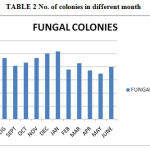Kavita Sharma1, Luka Rita2 and Sandhya Lanjewar3
1Arts and Commerce Girls college, Raipur (India).
2Goverment Girls P.G. College, Bilaspur (India).
3Goverment College Tilda (India)
Abstract
Microorganisms found everywhere in nature adapted to all kinds of the environment. Air acts as a vehicle for the dispersion of microorganisms. It introduces into air from different sources i.e. soil, water, organic waste of man, plant leaves, sneezes and cough. This study was conducted to collect the air-borne mycoflora from the environment of schools at Raipur, during the period from Feb.2008 to Jan.2009. A total number of 22 fungal genera were isolated. Genus Aspergillus was the most predominant followed by Alternaria, Penicillium, Curvularia, Cladosporium, Fusarium, Mucor, Rhizopus, Drechslera, Nigrospora, Trichoderma, and Bispora. During present study 1032 fungal spores were observed. The major types of airspora were Cladosporium sp. (12.69%), Aspergillus niger (11.53%), Alternaria sp. A (10.27%), Curvularia lunata (9.30%), and Drechslera (6.78%), Fusarium sp. (5.03%) to the total air spora. Higher concentration of spores was observed during January (104) and Lower in the month of April (75). The results provide to be helpful to allergologist and clinician in the treatment of fungal related disease.
Keywords
Airborne; mycoflora; schools; environment
Download this article as:| Copy the following to cite this article: Sharma K, Rita L, Lanjewar S. Aero Mycological Survey of School Environment. Biomed Pharmacol J 2011;4(1) |
| Copy the following to cite this URL: Sharma K, Rita L, Lanjewar S. Aero Mycological Survey of School Environment. Biomed Pharmacol J 2011;4(1). Available from: http://biomedpharmajournal.org/?p=1716 |
Introduction
Microorganisms always present in the nature and they migrate through one place to another by air current. Fungus is the common microorganisms in our environment, and always present in form of spores. There are multi-thousands of recognized species of fungi. They are found in soil, in water, on animals, on vegetation, in humans, and in almost every part of the environment. Anemophilous fungi are spread by the atmospheric air. Fungal spores are always present in the air. Due to increasing awareness of the relationship of airborne fungi to allergy in patients suffering from asthma and rhinitis, many scientists and allergists began to study the presence and type of fungal spores in both indoor and outdoor air. Therefore the aim of this study was to explore the air-borne fungal flora present in the school environments of Raipur city.
Materials and Methods
The gravity petriplate exposure method was used for the trapping of fungal spores using PDA (Potato Dextrose Agar) media at fortnightly intervals. Three petri plates were exposed for 5 to 10 min. in different schools of different localities in Raipur city. These localities were north, south, east and west. The exposed petriplates were brought to laboratory and incubated at 28 ± 1˚C for 6 to 8 days. At the end of incubation period the fungal colonies were counted, isolated and identified with the help of available literature. (Barnett, 1969 ; Nigmani et al. 2006).
Results and Discussions
During the investigation period total 1032 fungal colonies belonging to 22 species were observed.In the summer season307, in rainy 339 and in winter 386 fungal colonies were isolated. The major types of airspora were Cladosporium sp. (12.69%), Aspergillus niger (11.53%), Alternaria sp. A (10.27%), Curvularia lunata (9.30%), and Drechslera (6.78%), Fusarium sp. (5.03%) to the total air spora{table 1}. Higher concentration of colonies was observed during January (104) and Lower in the month of April (75).{table 2}.The results of present investigation revel with various work done by researchers.Majumdar & Ranjan(2007) isolated Aspergillus, Cladosporium, Alternaria in Kolkata.Roymon et.al. (2007) observed Aspergillus Cladosporium in comman public places. Aspergillus sp. was observed throughout the study period similar result was also reported by Tiwari et al. (2006). Anamorphic fungi recorded as the most contributed fungal group throughout the study period similar result also recorded by Tiwari et al. (2006). Sharma&Tiwari (2009) have also reported Aspergillus niger was most frequent fungal species during the investigation period.
Table 1: % Contribution of flora
| S.N. | FUNGI | %CONTRIBUTION |
| 1 | Alternaria alternata | 10.27 |
| 2 | Alternaria sp. | 1.25 |
| 3 | Aspergillus flavus | 5.91 |
| 4 | A. fumigatus | 7.75 |
| 5 | A.japonicus | 1.93 |
| 6 | A. nidulans | 1.93 |
| 7 | A. niger | 11.53 |
| 8 | A. temari | 1.74 |
| 9 | Bispora sp. | 1.74 |
| 10 | Cladosporium Sp | 12.69 |
| 11 | Curvularia lunata. | 5.81 |
| 12
13 |
Curvularia clavata
Drechslera sp. |
9.30
6.78 |
| 14 | Fusarium sp. | 5.03 |
| 15 | Mucor sp. | 1.93 |
| 16 | Mycelia sterilia (white) | 4.84 |
| 17 | Nigrospora sp. | 1.74 |
| 18 | Penicillium SP.A | 3.87 |
| 19 | Penicillium SP.B | 1.35 |
| 20 | Rhizopus sp. | 1.06 |
| 21 | Trichoderma viride | 1.35 |
| 22 | Unidentified | 0.19 |
 |
Table 2: No. of colonies in different month
|
References
- Barnett, H.K. (1969)” Illustrated genera of imperfect fungi.” Mins Burgss Pub. Co. Minneapolis, Minnesota.
- Majumdar Manas , Ranjan (2007). An assessment of the indoor mycoflora of school buildings in kolkata. 14th Nat Conf. p33.
- Nagamani, A., Kunwar, I.K. and Manoharachary, C. (2006) Handbook of Soil Fungi. I. K. International Pvt. Ltd. New Delhi (India)
- Roymon,M.G., Nafde, Seema K., Mukherjee, Arpita., Talukdar, Ayantika.(2007). Identification of some commonly occurring fungi isolated from indoor air samples of common public places. 14th Nat Conf. p34.
- Sharma K., Tiwari K.L. 2009 Aeromycoflora of ocimum sanctum Flora and fauna 15(1)21-24.
- Tiwari, K.L., Jadhav, S.K. and Kunjam, S.R. (2006) Aeromycoflora of Slum area of Raipur (C.G.). Ad. Plant Sci. 19(II) P: 387-390.







